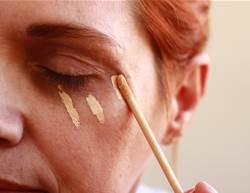The right brush can completely transform how your makeup looks—no doubt about it. It can mean the difference between a heavy, cakey finish and a seamless, natural result.
Once you’ve prepped your skin with your regular skincare routine, applied eye cream (to help smooth fine lines and prevent product from settling), and layered on SPF (it’s never too late to protect your skin), it’s time to choose your tools. Here are my go-to tips for picking and using the right brushes.
Use a flat brush for the face
For foundation, moisturiser, Miracle Balm or cream blush—any face product with a liquid or cream base—a flat, slightly rounded brush does the job best. I like using The Skin Brush because its non-animal fibres won’t soak up the product, allowing for smooth application without waste.
Try a multi-purpose one for eyes
When it comes to brows, I reach for The Eyebrow Brush. It has a spoolie on one end to brush through brows and a flat tip on the other that’s great for filling in sparse spots or doubling as an eyeliner brush.
For eyeshadow, a fluffy round brush works beautifully for lighter base shades—these often need more product. Then switch to a smaller brush to add depth and detail with darker tones.
Using liquid eyeliner? A thin, pointed brush gives you the most control. For powder eyeliner, a small, flat brush with a rounded edge helps create a soft, defined look.
Go big for blush and bronzer
Blush is one of my favourite ways to bring life back into the face. Powder formulas work best with a soft, fluffy brush (like the Blush Brush) that has a rounded edge—perfect for sweeping colour across the apples of your cheeks without applying too much at once.
For bronzer, choose a brush that’s wider and fuller. The bigger the brush head, the less precision is needed, making it easier to create a natural glow (the Bronzer Brush is ideal). I often reach for The Everything Brush for setting powder and blending—its broad shape and short bristles make stippling effortless.
Be strategic with application
Start light. It’s always easier to build up pigment than to remove it. Tap off any excess product before it hits your skin. After dipping the brush into the product, gently tap or blow on the bristles to avoid too much pigment settling into fine lines.
Clean your tools
Makeup brushes don’t need daily washing, but they do need regular cleaning. Aim to wash them every three to six months depending on how often you use them. Use mild soap and water, then wring out the bristles gently. Avoid drying them on a towel, as this can cause mildew. Instead, hang your brushes over the edge of the sink so air can circulate through the bristles as they dry.









.png&h=193&w=250&c=1&s=1)
